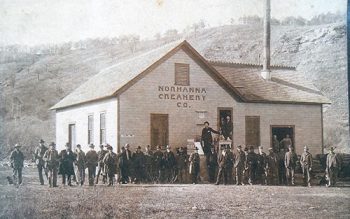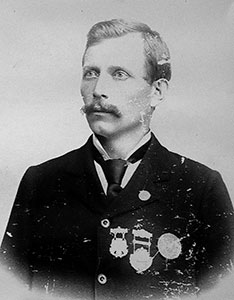
They were married in the king’s palace in Norway. Otto and Caroline Bach, at ages 26 and 24 respectively, and his mother Otilia sailed to New York in 1885 with second-class passage purchased at a country store and post office in Newburg, Fillmore County, Minn., by Otto’s brother and previous immigrant, Mathias Johnson. The newcomers first settled in Newburg and later lived in Mabel and then the Vinegar Hill settlement near Rushford.
Back in Norway, to avoid confusion in the mail, Otto and three brothers changed their family name from Johnson (Jonson) to Bach, after a nearby town. Later in Minnesota, his name became associated with excellence and with the village of Choice.
Choice (current population, about six or seven), located on Highway 43 in a picturesque valley below towering bluffs along the South Fork of the Root River, is about 11 miles south of Rushford and the same distance north of Mabel. About 1900, someone in Minneapolis established the Normanna Creamery in Choice, and Otto Bach was the choice to be the first butter maker, where he won two medals as a Minnesota champion butter maker. In a corner of the creamery, there was a brick butter room, which was kept cool with ice harvested from the river before being stored in sawdust in the ice house.
Otto, in October of 1906, went to North Dakota to file a claim to homestead. He returned to Minnesota to prepare the family to move the following spring. They had eight children, four of whom died in childhood. Caroline and children would make it to North Dakota, but Otto would not. He became ill with stomach cancer that winter and died in March of 1907 at age 48. An obituary identified him as a resident of Vinegar Hill; he was buried in the Mabel Cemetery.

Photo submitted
Before his death, Otto urged his wife and children to follow through with plans to move west and entrusted their care to his brother Herman. Not pleased with prospects on the prairie, Herman soon returned to Minnesota. However, Caroline remained in North Dakota for 35 years until her death in 1942.
Back in Choice, after about five years as the Normanna Creamery, the enterprise became the Choice Creamery. Since the creamery closed about 1926, the adjoining house, built in 1922 by the last butter maker Lew Torgerson, has remained a residence, currently the home of Jeff and Louane Davidson. Jeff uses the old creamery building as a shop and garage. He said that for a while after the creamery closed as a business, the building served as an entertainment venue with a small stage and bleacher seating.
The creamery house resident immediately prior to the Davidsons was Clara Anderson, who would walk 11 miles to Mabel to buy groceries and then wait until someone from Choice was available to drive her home. In 1966, at age 85, she said, “Choice was a lively place years ago. Every night 35 to 40 people would congregate at the store to discuss current events, play cards or just visit. People were more content in those days.”
There was also organized festivity. The Fourth of July was celebrated in the early years, dating back to the first observance in 1897 at picnic grounds west of town. There was a concert by the Highland Cornet Band along with orations, foot races and a ball game. A hand-operated merry-go-round arrived from Rushford, and Henderickson’s Orchestra played for a bowery dance.
There were summers when a caravan arrived with a traveling medicine show, which set up tents for several days of entertainment.

Photo submitted
At one time, Choice and Tawney had the only two country stores in Preble Township. The first store in Choice was built by Melgord and Lucason sometime before the late 1880s when it was sold to Swen Thompson, who became the first postmaster. The mail was delivered from Bratsberg by Mikkel Kulseth in a two-wheel, horse-drawn cart. Today, the mail comes from Mabel as it has for decades.
About 1899, Ole Richardson built another store north of the crossroads, which was sold several times, including 1905, 1912 and about 1935. A telephone exchange operated from the store with as many as nine direct lines to various area towns, including multiple lines to both Mabel and Rushford along with lines to Lanesboro and Highland.
The store burned on December 21, 1945, when an oil company serviceman overestimated the capacity of the underground gasoline storage tank. Gasoline overflowed and seeped into the wood furnace and resulted in an explosion. Four people inside the building managed to escape unharmed. Bruce Larson, who was age 11 at the time, said, “Dad (Clifford Larson), Myron (Larson, his dad’s brother), the Standard Oil man from Mabel and I were in there. I was blown about three feet off the ground, We all got out the door. I don’t know how, but we were lucky; we all got out.”
His uncle Myron, a man of considerable physical strength, claimed he caught the airborne cash register in mid-air during his hurried escape.
Diane Larson (age nine at the time) recalled, “I was in the house when I heard the explosion. I didn’t know what it was. I ran to the window and saw people running out of the store. The whole building was covered with flames.”
Two large government grain storage buildings were moved to the site and then connected by a breezeway. There, the store remained in business until closing in the mid-1960s. The building, now under one roof, still stands and serves as a storge building.
The school was organized in 1863, and a log schoolhouse was built the following year. Later, a frame school building was constructed. The school closed in 1953 when the district was consolidated with Rushford. The school building became a dwelling after being moved to a nearby farm and later moved again to Newburg.
In 1874, a Methodist chapel was built in Choice where regular services were conducted until 1952 when it was sold and finally razed.
Sources: Fillmore County History, 1984; La Crosse Tribune article, “Their Choice: Hamlet Peaceful as Flowing Creek” by Burr Griswold, June 1966; personal recollections of Jeff Davidson.


Leave a Reply